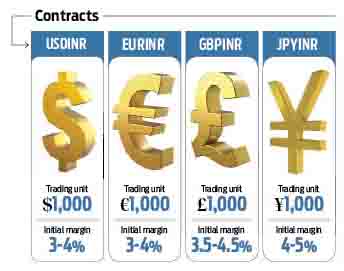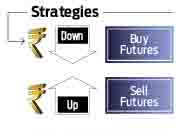How to make future perfect for your Rupee
In a world of frequent fluctuations, smart use of currency futures can not only help you cover rupee risks, it will also help you make money

It is often said that the world is getting smaller and nowhere is this more apparent than in the increasingly globalised world of international commerce. Trade is no more based on a single currency. You have the dollar, pound, yen and many more making a basket of currencies that is needed for business to run smooth. No wonder a 50 paise variation can set off a business hugely as it may put off your foreign travel plans or impact needs of students aspiring to study abroad. In the past year, the rupee has been range bound, moving between Rs. 58 and Rs. 63 to a dollar, which is an 8-8.5 per cent variation. Since May this year, the rupee has steadily gone up bringing cheer to those who are thinking of spending in dollars and putting off those earning in dollars and converting the same to rupees. It is in this context that currency futures come to play to help both the parties hedge their currency risk.
 Why currency futures?
Why currency futures?
Currency risk is the risk one would incur due to movements in a currency pair. For instance, if you are exporting food items to the US for Rs. 6.3 lakh, when the dollar is Rs. 63 with a 90 days credit, you would receive $10,000 after three months. Now assume that the rupee appreciates to Rs. 60 to a dollar at the end of three months, you would receive Rs. 30,000 less than what you would receive now. Currency futures can help cut such losses. In this case, you could sell 10, three-month futures contracts at the rate of Rs. 63 per dollar. If the exchange rate appreciates to Rs. 60 after 3 months (when payment is due), you would make a profit of Rs. 3 per dollar or Rs. 30,000 (3 x 1000 x 10). This would help you get back the Rs. 30,000, which you would lose due to rupee appreciation. Traditionally, importers and exporters have been using netting or invoicing to deal with exchange risks. Netting is when an equal amount of foreign receivables as well as payables are maintained. But this is not ideal for small businesses who deal with small amounts of currency. Smelling opportunity, banks came up with the concept of forward contracts wherein you agree to buy or sell a predetermined amount of foreign currency at a pre-determined exchange rate, but at a future date. The biggest disadvantage with forward contracts is the fact that when the spot or market price is favourable, you would be penalised if you exit the contract.
Future’s the way 
Says Kishore Narne, associate director, head-commodity & currency, Motilal Oswal Commodity:“Forwards lock the time along with the price. This closes the option to exit the contract in between if needed.” Naveen Mathur, associate director–commodities & currencies, Angel Broking says, “In case of futures, standardisation helps to create liquidity in the market and clearing house guarantees against default risk.” This is the reason why you should be using currency futures. Futures closely resemble forwards except that futures contracts are marked to market (MTM) at the end of the day and one can exit the contract any time before it expires. The biggest advantage with futures is the minimum investment needed. Currency futures margins range anywhere between 3 and 5 per cent, which means even students and travellers, can consider the same given the small size of the contract. For instance, 1 USDINR contract has a unit of 1,000 USD. Transaction impact cost is also very low. The best part is that you can be assured of the best prices and the price quoted would be the same across participants. “In currency futures, price discovery happens within a larger market whereas in the case of forwards, it is a contract between two parties at a negotiated rate which can vary from bank to bank,” says Vikas Vaid, product head-commodity & currency at Prabhudas Lilladher. In comparison, banks quote exchange rates based on various parameters and would differ from one customer to another and lack transparency. The bigger the amount you deploy the better would be the rate (lesser the premium) offered by banks. This is totally ruled out in case of the currency futures market where price is a function of demand and supply. Add to this, high liquidity that would allow easy entry to and exit from the market. Things are even better now that foreign institutional investors can participate. Do remember that even though currency futures are highly useful, they entail great risks too. So what should be your strategy? Mathur suggests selling MCXSX or NSE USDINR around Rs. 62.50-Rs. 62.60, stop loss – Rs. 63.50, target –Rs. 61.00/ Rs. 60.80.









